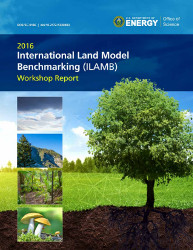| layout | title |
|---|---|
default |
ILAMB |
The International Land Model Benchmarking (ILAMB) Package was designed to address the goals of the ILAMB Project, a model--data intercomparison and integration activity. The ILAMB project was initiated to improve the performance of land models and, in parallel, improve the design of new measurement campaigns to reduce uncertainties associated with key land surface processes. Building upon past model evaluation studies, described below, the goals of ILAMB are to:
- develop internationally accepted benchmarks for land model performance,
- promote the use of these benchmarks by the international community for model intercomparison,
- strengthen linkages between experimental, remote sensing, and climate modeling communities in the design of new model tests and new measurement programs, and
- support the design and development of a new, open source, benchmarking software system for use by the international community.
Improving the representation of the carbon cycle and land surface processes in climate models requires extensive comparison of model results with observations. This process is difficult and time intensive. Past data-model intercomparisons have strengthened the representation of key processes in land models, but often this information has not been easily accessible for use by other modeling teams or in future intercomparisons. Specifically, there is a large cost in developing the infrastructure to make meaningful model--data comparisons, even when the data are freely and easily available. Further, the development of sophisticated model diagnostics programs---that can fully exploit the richness of large Earth System data sets like satellite or Fluxnet measurements---are outside the scope of any single modeling center. Thus, an important direction for the field is the development of a community-based model evaluation system that is open source and modular, allowing for contributions by many different modeling and measurement teams.
Multiple past intercomparison efforts provide a foundation a new international benchmarking activity. The original C4MIP effort provided the community with an elegant conceptual framework for diagnosing the causes of model-to-model differences in feedback strength (Friedlingstein et al., 2006; Gregory et al., 2009). The Carbon-Land Model Intercomparison Project (C-LAMP) also was a first step in this direction (Hoffman et al., 2008; Randerson et al., 2009. Nine different classes of observations were used to evaluate two biogeochemistry models (CASA′ and CN) within the Community Climate System Model. For each class of observations, the models received a score based on the quality of the fit with the measurements. Information from different data streams were weighted by the relative importance of the observational constraint, the uncertainty in the observations, and the uncertainty in the model.
The 2016 ILAMB Workshop was convened in May 2016 in Washington, District of Columbia, USA, to engage the international research community in defining scientific priorities for (1) design of new metrics, (2) improvement of model development and workflow practices, (3) Coupled Model Intercomparison Project (CMIP) evaluation, and to learn about new observational data sets and measurement campaigns. The workshop drew more than 60 on-site participants, and between 20 and 30 individuals---including students and postdocs---attended online at any time during the plenary sessions. Participants were from Australia, Canada, China, Germany, Japan, Netherlands, Sweden, United Kingdom, and the United States and represented 10 different major modeling centers. Plenary presentations focused on model benchmarking, emergent constraints, evaluation metrics, uncertainty quantification, and field experiment and measurement networks. The 2016 ILAMB Workshop Report (Hoffman et al., 2017) is available here.
The ILAMB Package provides a variety of in-depth diagnostics of more than 24 terrestrial biogeochemical and hydrological model variables on annual and inter-annual time scales. It compares these variables with over 60 site-based, regional, and global observational data sets, and scores model performance based on a combination bias, RMSE, and seasonal cycle metrics. Relationships between many biogeochemical variables and physical driver variables are calculated from model results and compared with observational estimates. ILAMB is useful for detailed exploration of land biogeochemical and hydrological model responses and provides an interactive interface designed to enable the user to more rapidly understand the underlying drivers of those responses. The ILAMB version 2 system design philosophy and implementation are described by Collier et al. (2018).
Quick links:
Repository,
Installation,
Tutorials,
CMIP5 Results,
and CLM Results
Contact: Forrest M. Hoffman (forrest@climatemodeling.org)
